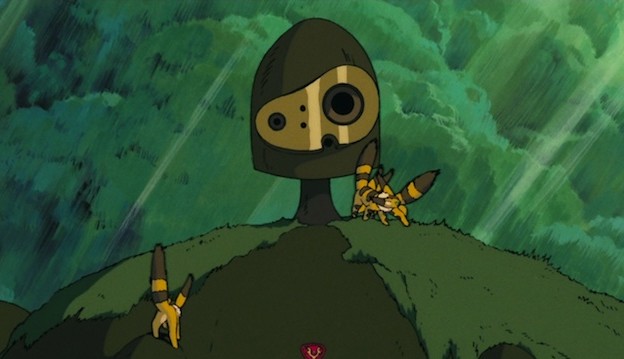Rapyuta, a Collective Brain for Robots in the Cloud
March 11, 2013
on
on

Old school robots don’t particularly like unstructured environments such as the homes of us messy humans. Objects are moved, task descriptions change and there is just no way to structure responsibilities into repetitive automated processes. Which is why they’ve mostly kept to ordered, predictable places like factories.
But a new generation of robots ventures into the disorderly world of humans. In order to cope, a stand-alone robot needs a wide array of sensors to map out its changing surroundings and a lot of computing power to process the sensor data. But a heavy workload means a lot of power consumption, chaining the bots to wall sockets or restricting their operational time due to battery limitations.
To overcome these restrictions European scientists built Rapyuta, a framework that harnesses the power of the Internet to enable individual robots to offload their computations to the collective. Rapyuta -named after the 1986 Japanese movie Tenkû No Shiro Rapyuta about a castle in the sky inhabited by robots- is a cloud-based environment running customizable robotics applications on secured servers.
In a scientific paper [PDF] roboticist Dominique Hunziker and his co-authors explain that the engine is a Platform-as-a-Service (PaaS). ‘In PaaS the cloud computing platform typically includes an operating system, an execution environment, a database, and a communication server.’ These kind of platforms already exist for web applications but because robotics has different requirements, the team built this new open source framework.
Rapyuta is part of the open source RoboEarth project which works on the development of cloud robotics. To that end the project has produced several frameworks for networked robots. In 2011 the RoboEarth database was launched in an effort to create a world wide web for robots. The database enables robots with different hard- and software specifications to create and maintain collective knowledge repositories. If robot X figures out how to refill a Nespresso coffeemaker it can upload the action recipe to the database making it available to robot Y.
The RoboEarth database makes it possible to build economically efficient robots. With access to the collective memory, robot Y doesn't need the expensive sensor array and complex learning capabilities robot X needed to solve the Nespresso problem. And with the emergence of the Internet of Things, networked robots can function as the arms and legs of the Internet.
Now, with the launch of Rapyuta the bots do not only have a collective memory but they can also draw on external processing power. The cloud engine can easily interact with the RoboEarth database, creating a collective brain in the cloud.Paving the way for the emergence of an army of lean, low-cost, mobile robots which can solve problems in a team effort.
RoboEarth a multinational collaborative project of universities and corporations funded by the European Union.
Image: Tenkû No Shiro Rapyuta robot on: news-anime.com
But a new generation of robots ventures into the disorderly world of humans. In order to cope, a stand-alone robot needs a wide array of sensors to map out its changing surroundings and a lot of computing power to process the sensor data. But a heavy workload means a lot of power consumption, chaining the bots to wall sockets or restricting their operational time due to battery limitations.
To overcome these restrictions European scientists built Rapyuta, a framework that harnesses the power of the Internet to enable individual robots to offload their computations to the collective. Rapyuta -named after the 1986 Japanese movie Tenkû No Shiro Rapyuta about a castle in the sky inhabited by robots- is a cloud-based environment running customizable robotics applications on secured servers.
In a scientific paper [PDF] roboticist Dominique Hunziker and his co-authors explain that the engine is a Platform-as-a-Service (PaaS). ‘In PaaS the cloud computing platform typically includes an operating system, an execution environment, a database, and a communication server.’ These kind of platforms already exist for web applications but because robotics has different requirements, the team built this new open source framework.
Rapyuta is part of the open source RoboEarth project which works on the development of cloud robotics. To that end the project has produced several frameworks for networked robots. In 2011 the RoboEarth database was launched in an effort to create a world wide web for robots. The database enables robots with different hard- and software specifications to create and maintain collective knowledge repositories. If robot X figures out how to refill a Nespresso coffeemaker it can upload the action recipe to the database making it available to robot Y.
The RoboEarth database makes it possible to build economically efficient robots. With access to the collective memory, robot Y doesn't need the expensive sensor array and complex learning capabilities robot X needed to solve the Nespresso problem. And with the emergence of the Internet of Things, networked robots can function as the arms and legs of the Internet.
Now, with the launch of Rapyuta the bots do not only have a collective memory but they can also draw on external processing power. The cloud engine can easily interact with the RoboEarth database, creating a collective brain in the cloud.Paving the way for the emergence of an army of lean, low-cost, mobile robots which can solve problems in a team effort.
RoboEarth a multinational collaborative project of universities and corporations funded by the European Union.
Image: Tenkû No Shiro Rapyuta robot on: news-anime.com
Read full article
Hide full article


Discussion (0 comments)